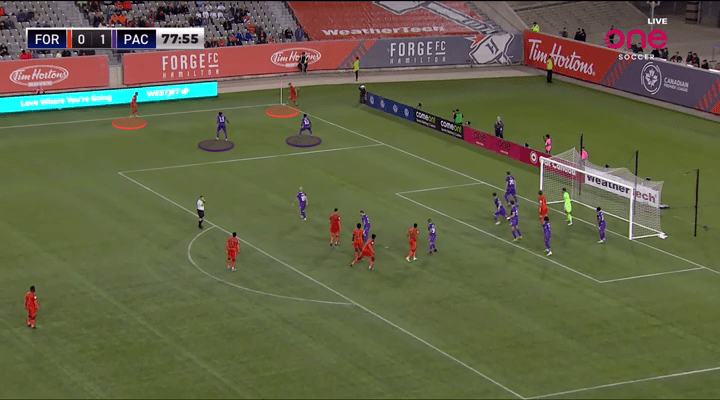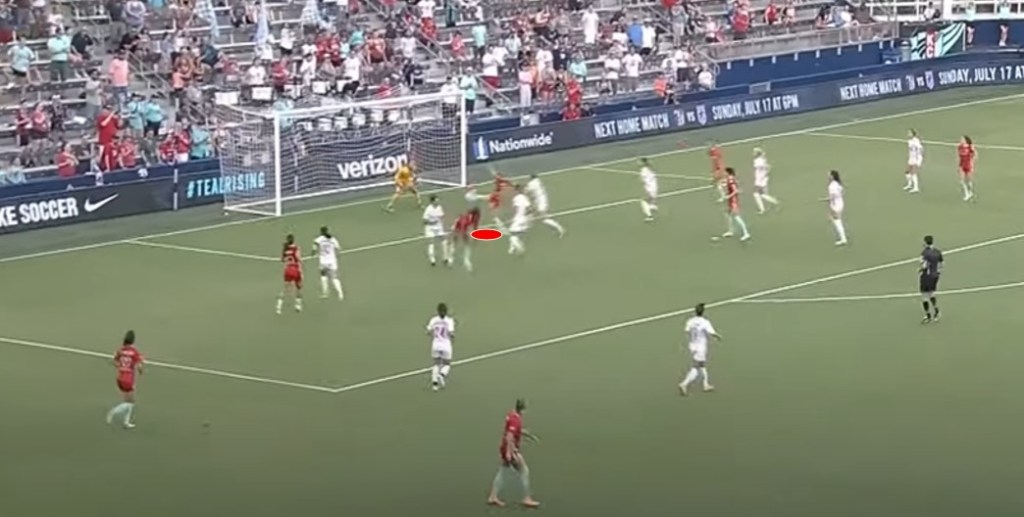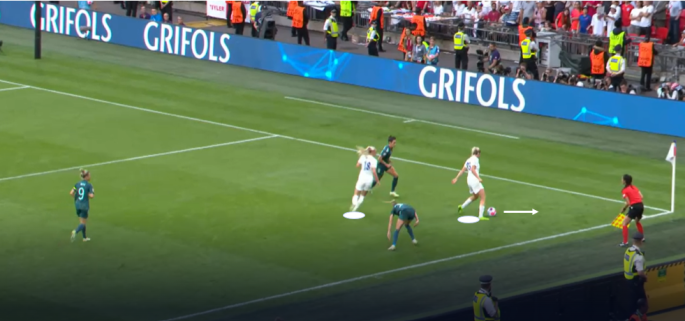
Among a host of changes to the game and innovations popping up at every turn, short corners remain an understudied facet of the game. While they often frustrate fans in stadiums when they ultimately come to nothing, the right short corner kick routine can bear fruit for any team, creating an overload before whipping the ball into the box.
In recent conversations with a former CMNT player, he mentioned to me how he’d say in any other phase of the game that it would be the wrong decision to cross the ball in from that angle, and not take a 2v1 on when the opportunity presents itself. His argument to short corners was then – why not take that opportunity? Naturally, this sparked my imagination. With that, here is a case study as to why short corners have the potential to work so well, and why the groans in the stands could turn to cheers and jubilation in the future.

In any short-corner, you have the potential to create an overload in the wide area, exploit the opposition, draw them out, and then deliver a pass into the penalty area from a better angle. That “better angle” allows you to cross the ball further away from the keeper’s goal, potentially with fewer defenders in the box to defend the situation. But it can also allow the team to cross the ball closer to the opposition’s goal, as defenders rush out to stop the cross.
CPL Playoff victors Forge FC made a habit of creating moments of magic from short corners this season, utilizing these moments to create a 2v1 up against an unsuspecting defender. They frequently added a third to the mix at the top of the box, allowing multiple crossing angles to be used depending on the reaction of the opposition.

This particular example comes from a game toward the end of the season against York United, where the incisive David Choinière combined with playmaking master Tristan Borges. Instead of playing in that third member of the team at the top of the box, Choinière returned the pass to Tristan Borges instead, with the York defender caught flat-footed and utterly unaware of what to do.

As the ball then came across to Borges at the edge of the eighteen, another York defender was lured into the situation, right before Borges put the ball over the keeper’s head and on a plate for Malik Owolabi-Belewu. The Hammers made this goal look incredibly easy, and the truth is, it would be incredibly easy for any team to replicate this 2v1 scenario.
A short-corner routine can allow a possession-based side like Forge to continue to see out their principles, without lumping a long pass into the box where they don’t have many physically imposing players to contest the situation.

The opposition will usually react by positioning at least one player in front of the short-corner option, but the team in possession can still assess the distance of that player away from the situation, and work to exploit the situation.
Moments before Giovanni di Lorenzo scored his short-corner header against Ajax in the Champions League, here we can see Ajax’s nearest player making no attempt to close down the situation, as Dusan Tadic races from some distance away to stop the cross.

Kvicha Kvaratskhelia is then afforded plenty of space to get his head up and see Di Lorenzo, freed up from the blocking power of Andre Anguissa in front of him.
So it’s normal then for the opposition to react to a team consistently playing short corners by equalizing the situation. Improvisation can then inspire new crossing angles, where a third player can enter the mix from afar and deliver the ball into the box. As the opposition rush out to keep players offside, disorganization at the back is bound to occur.

Perhaps the best example of this came from KC Current earlier in the season, where Chicago responded by positioning three players up against their three, yet still failed to defend the situation.

This meant that KC didn’t have any sort of overload, whilst actively taking players out of the box. As you can see from the distances in the image, if Hailie Mace now passes to either of her teammates, they won’t be afforded much time or space to deliver a cross. But with the right movement and rotation, anything can happen. That’s the beauty of the short corner, and the potential it provides in opening new angles.
The move starts by the corner taker (Mace) playing the ball into Victoria Pickett, as a third player – Alexis Loera hangs at the top of the box. Pickett takes her first touch toward where she’d like to cross, but the defenders are left flat-footed and muddled as Mace and Loera then swap positions, overlapping either side of Pickett.

Pickett continues advancing toward the defender, as Chicago’s defensive line simultaneously step away from goal, in the quest to keep KC players offside. But as they ball watch the situation unfold, Kristen Hamilton is able to get herself in between defenders, and in a great position to receive a cross.

Pickett then fakes the pass to Loera, as Mace is left freed up at the top of the box to deliver the cross from a different vantage point. Throughout this period, not a single Chicago player steps out to make a challenge, yet the entire defensive line steps out together to try and force Hamilton offside. Unfortunately for them, at the moment that Mace delivers the cross, Elizabeth Ball pegs a Chicago defender back, keeping Hamilton free to surge forward at exactly the right moment.

There’s then nothing left for Hamilton to do except finish the chance from close range, giving Alyssa Naeher no chance.

The KC Current example provides every element of why a short corner kick routine can work when meticulously structured. Even despite Chicago equalizing the situation by positioning three players up against their three, KC’s mix of movement, rotation, disguise, and timing perfectly opened up the scoring opportunity. This happened at the beginning of KC’s rise up the NWSL table, and for a while, they relied on set-piece brilliance to score crucial goals. We even analyzed a short corner routine from the Current one week before this brilliance transpired. But importantly, that “routine” was completely different from the one we analyzed above, meaning the opposition simply don’t know what a team like KC will do from set-pieces.
Before closing the article, it’s important to note that short corners are not only great for creating opportunities when done right, but ideal for killing down a game, running the clock and seeing out a victory. England used their short-corners to great effect in the Women’s Euros final against Germany at the end of the game, frustrating the Germans into oblivion.

So while they may frustrate fanbases across the globe. Short corners open up corridors to cross the ball in from different angles, create overloads out wide, and quite simply confuse the opposition into crucial mistakes. They also afford a team one more way of killing down the game late on in matches, in perhaps the only universally agreed upon usage of the art. Short corners may start to get the credit they deserve as innovative managers look to create innovative routines around their set-pieces, and use the art to score fantastic goals. The opportunities are endless, and like anything in football, there is no one right or wrong way to play the game. So, you may want to stop bemoaning short corners.
So there it is! The case for short corners in football. Be sure to check out more of our set-piece analyses, and follow on social media @mastermindsite. Thanks for reading and see you soon!
YOU MIGHT ALSO ENJOY…
Why Jesse Marsch is perfect for the Canadian Men’s National Team
The American coach made his name across an incredibly successful spell at RB Salzburg between 2019-2021, but hasn’t been able to hold down the fort since. His brief stints at RB Leipzig and Leeds United showed signs of promise, but also many moments of doubt. So with Marsch being out of a top-tier job for…
Pep Guardiola – Manchester City – Tactical Analysis (2023-24)
This might finally be the year. It might finally be the year that Pep Guardiola and Manchester City don’t win the Premier League. Despite that, they’ve still been the most tactically complex team in the league, carrying on from much of the tactics that brought them a treble-winning triumph last season. Here is what Pep…
Game of Numbers #38 – Alejandro Garnacho’s intensity & awareness
It’s amazing to think that Alejandro Garnacho is only 19 years of age. Sometimes, you can see the rawness in his game. The facets that still need to be carefully developed. But as he ages, let’s hope he never loses his tenacity. His hunger for more. His appetite to win at all costs, even when…





Appreciating the time and effort you put into your website and in depth information you offer. You’ve really covered up almost all the possible info that every soccer enthusiast should follow who is so curious about the case for short corners. Worth sharing! Please continue sharing your updates! Thanks a lot!
LikeLike
Thanks for your kind feedback Jonathan! Love sharing the work so anytime you want to see something always let me know! – Rhys
LikeLike